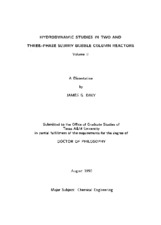| dc.contributor.advisor | Bukur, Dragomir B. | |
| dc.creator | Daly, James G. | |
| dc.date.accessioned | 2020-09-07T18:26:27Z | |
| dc.date.available | 2020-09-07T18:26:27Z | |
| dc.date.issued | 1990 | |
| dc.identifier.uri | https://hdl.handle.net/1969.1/DISSERTATIONS-1174815 | |
| dc.description | Typescript (photocopy). | en |
| dc.description.abstract | Two and three-phase bubble columns have been used in various industrial processes. Bubble columns were initially used in the fermentation industry but more recently have been used as bioreactors and chemical reactors. One particular application of bubble column reactors is for Fischer-Tropsch synthesis. Some desirable characteristics of bubble columns are: ( 1) simplicity in operation, (2) low investment cost, and (3) flexibility in operation. The major drawback associated with bubble column reactors is the uncertainty associated with scale-up. In order to properly design and scale-up multiphase reactors, both hydrodynamic and kinetic parameters are needed. The hydrodynamic parameters are often obtained in a non-reacting system; while, the kinetic parameters are obtained from a reactor designed to eliminate physical transport resistances. Experiments conducted in non-reacting systems are less expensive and provide information needed for scale-up. The primary purpose of this research was to conduct a systematic study of the effects of solids concentration and upward slurry flow on average gas holdup, axial and radial gas holdup, and axial solids distribution using molten waxes as the liquid medium. Superficial slurry velocities up to 2 cm/s and solids loadings up to 30 wt% iron oxide and silica were used in this study. A dual energy nuclear density gauge was designed to measure axial and radial gas holdups in a large diameter bubble column (0.21 m ID). Bubble size distributions and specific gas-liquid interfacial areas were obtained using the dynamic gas disengagement technique. Flow regime transitions were determined in both a small diameter (0.05 m ID) and large diameter bubble column using statistical analysis of both pressure fluctuations and nuclear density gauge fluctuations. | en |
| dc.format.extent | 2 volumes | en |
| dc.format.medium | electronic | en |
| dc.format.mimetype | application/pdf | |
| dc.language.iso | eng | |
| dc.rights | This thesis was part of a retrospective digitization project authorized by the Texas A&M University Libraries. Copyright remains vested with the author(s). It is the user's responsibility to secure permission from the copyright holder(s) for re-use of the work beyond the provision of Fair Use. | en |
| dc.rights.uri | http://rightsstatements.org/vocab/InC/1.0/ | |
| dc.subject | Major chemical engineering | en |
| dc.subject.classification | 1990 Dissertation D153 | |
| dc.subject.lcsh | Fischer-Tropsch process | en |
| dc.subject.lcsh | Hydrodynamics | en |
| dc.subject.lcsh | Multiphase flow | en |
| dc.subject.lcsh | Fluidized reactors | en |
| dc.title | Hydrodynamic studies in two and three-phase slurry bubble column reactors | en |
| dc.type | Thesis | en |
| thesis.degree.grantor | Texas A&M University | en |
| thesis.degree.name | Doctor of Philosophy | en |
| thesis.degree.name | Ph. D | en |
| dc.contributor.committeeMember | Best, Fred R. | |
| dc.contributor.committeeMember | Gadalla, Ahmed M. | |
| dc.contributor.committeeMember | Watson, Albert T. | |
| dc.type.genre | dissertations | en |
| dc.type.material | text | en |
| dc.format.digitalOrigin | reformatted digital | en |
| dc.publisher.digital | Texas A&M University. Libraries | |
| dc.identifier.oclc | 24160301 | |



